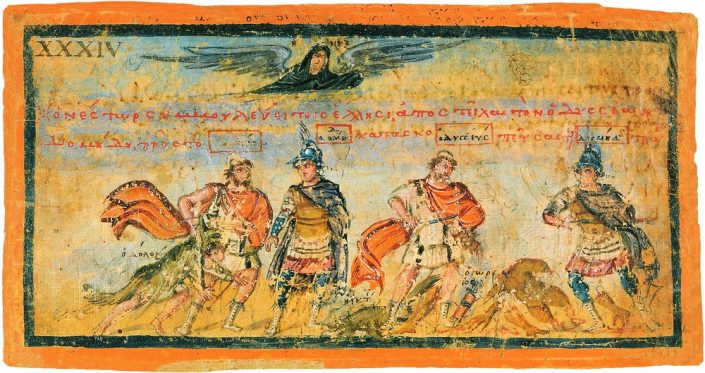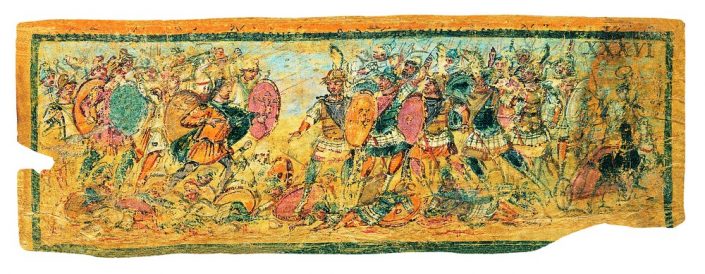The Ambrosian Iliad • ILIAS PICTA
The Ambrosian Iliad: the only ancient illustrated manuscript of Homer’s Epic
The Ambrosian Iliad, also known as Ilias Picta (Milan, Biblioteca Ambrosiana, Cod. F. 205 Inf.), is a remarkable 5th-century illuminated manuscript crafted on fine vellum. This exceptional codex uniquely depicts the entire narrative of Homer’s Iliad, featuring both intense battle scenes and dignified moments of nobility. It holds the rare distinction of being the only surviving set of ancient illustrations that visually represent key episodes from the Iliad. It offers an unparalleled glimpse into early interpretations of Homeric epic through Byzantine artistic lenses.
This manuscript’s combination of literary completeness and visual richness makes it an invaluable cultural artifact. Its 58 detailed miniatures bring Homer’s heroic tales to life with vivid imagery. That makes the Ambrosian Iliad a cornerstone of classical literature and medieval illumination. For historians, classicists, and art lovers alike, it remains a singular witness to how ancient audiences engaged with one of the greatest works of Western literature—not just through text, but through captivating art.
Discover, own, and admire a timeless treasure: The Ambrosian Iliad fine facsimile by Patrimonio Ediciones
Experience the awe-inspiring beauty of one of antiquity’s greatest masterpieces with the fine facsimile edition of the Ambrosian Iliad, meticulously produced by Patrimonio Ediciones. This limited edition faithfully reproduces every detail of the original 5th-century illuminated manuscript—from the colors and delicate brushstrokes to the materials used by ancient artisans.
Owning this facsimile means holding a piece of history in your hands—an opportunity to appreciate the extraordinary craftsmanship, artistic brilliance, and cultural significance of the Iliad Picta as never before. Whether you are a scholar, collector, or lover of classical art, this edition invites you to explore and contemplate the timeless stories and images that have inspired generations across centuries.
Discover the Ambrosian Iliad fine facsimile by Patrimonio Ediciones—where history, art, and literature converge in a masterpiece reborn for modern audiences.
Dating: 5th century; c. 493
Language: Ancient Greek written in capitals
Provenance: Constantinople or Alexandria
Patron: Emperor Anastasius I
Dimensions: approx. 22.4 x 18.9 cm.
Length: 102 pages containing the fragments that have been preserved.
Illustrations: 58 miniatures
Location: Biblioteca & Pinacoteca Ambrosiana, Cod. F. 205 Inf.
The Ambrosian Iliad: a 5th-century alexandrian masterpiece comprising 58 illustrated miniatures

The Ambrosian Iliad or Ilias Picta, also known as the Iliad Picta, is a unique illuminated manuscript consisting of 58 meticulously crafted miniatures, each clearly labeled with numbers to guide the viewer through the epic narrative of Homer’s Iliad. These vivid illustrations provide a rare visual journey into the ancient world, depicting scenes of heroic battles, divine interventions, and moments of nobility with exceptional artistic skill.
The alexandrian origins of the Ambrosian Iliad or the Iliad Picta
Art historians widely agree that this remarkable manuscript was created in Alexandria, a prominent cultural and artistic center of late antiquity.
The manuscript is thought to have been produced around the year 500 AD, during a time when Alexandria remained a cultural crossroads of the eastern Mediterranean. Its renowned artistic schools, libraries, and scriptoria attracted some of the finest minds and artisans of the time.
This attribution is primarily based on the distinctive style of the miniatures, characterized by flattened and angular Hellenistic figures—an artistic hallmark typical of Alexandrian art from around 500 AD.
The artists behind the Ambrosian Iliad: masters of alexandrian late Antique Art
It is believed that multiple artists contributed to the creation of the Ambrosian Iliad, working collaboratively to produce a coherent visual narrative that complements Homer’s text. The artists employed a technique reminiscent of ancient Greek vase painting, initially sketching nude figures before painting garments and armor on top, which adds depth and realism to the compositions. This method, combined with the manuscript’s carefully numbered miniatures, underscores the sophisticated craftsmanship and intellectual environment of Alexandria during this period.
In the 11th century, the miniatures were cut out of the original manuscript and pasted into a Siculo-Calabrian codex of Homeric texts.
A unique style among other illuminated manuscripts
The style reflects a unique blend of classical Greco-Roman traditions infused with early Byzantine influences, resulting in images that are both expressive and stylized.
Comparisons of texts per page to other late antique manuscripts (Vatican Vergil, Vienna Genesis) hasled some to speculate these miniatures were originally part of a large manuscript. This manuscript was unlike other illuminated manuscripts in its lack of gilding. Instead, the author(s) chose yellow ochre to represent gold within the individual images, i.e. the gold cuirasses of noble figures, and the halo of Zeus (folios XXXIV).
A philological treasure: the Ambrosian Iliad’s rediscovery in modern times
Cardinal Angelo Mai and the Scholarly Significance of the Manuscript
In the early 19th century, Cardinal Angelo Mai, then librarian of the Biblioteca Ambrosiana, recognized the Ambrosian Iliad as a document of extraordinary value. Convinced that the manuscript dated back to the 3rd century, he emphasized its philological importance as a primary witness to ancient literary and artistic traditions. While modern scholarship places its origin closer to the year 500 AD, the manuscript remains a central object of study for understanding Homeric reception, Byzantine illumination, and the evolution of narrative illustration.
Today, the Ambrosian Iliad—or Iliad Picta—continues to captivate historians, classicists, and art experts worldwide. Its facsimile edition by Patrimonio Ediciones offers a rare opportunity to experience this visual epic in its most authentic and meticulously reproduced form.

Patrimonio Ediciones
The only company which uses pure gold and true precious stones for its facsimiles of the most beautiful manuscripts in the world
Address
C/Martín el Humano,12.
46008 Valencia
Phone (+34) 963 82 18 34
info@patrimonioediciones.com
Schedule
Monday to Friday: 9:00-14:00 / 16:00-18:00
Saturday: Closed
Sunday: Closed















